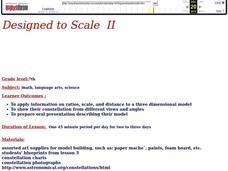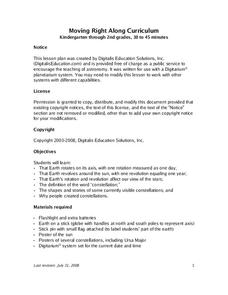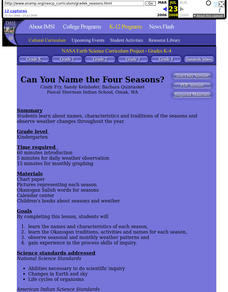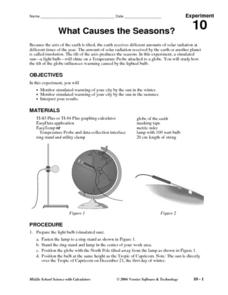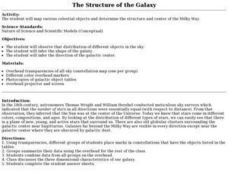Curated OER
The Seasons
Discover the change of the seasons by modeling the Earth-Sun system. Learners model the orbit of the Earth around the sun and explore how and why the patterns of winter and summer occur.
Curated OER
Modeling the Big Bang and the Formation of the Universe
Sixth graders conduct an experiment to understand the Big Bang Theory. In this Big Bang Theory lesson, 6th graders will observe a balloon with confetti popping to emulate and analyze information related tot he Big Bang theory. Students...
Curated OER
Moon Crash
In this moon crash worksheet, students research information about the moon. In a given scenario, students decide which emergency supplies to take in order to survive on the moon.
Curated OER
Black Holes IV
In this black holes worksheet, learners read about black holes and solve 3 problems where they calculate the Schwarschild radius of one, the number of grams/second a quasar luminosity implies for another and the number of suns per year a...
Curated OER
The Sky Jeopardy
First graders reinforce concepts about sun, moon, day, night and sky by playing the Sky Jeopardy game. In the end, 1st graders get to nibble crackers in order to show the different phases of the moon.
Curated OER
The Wanderers: Planets of Our Solar System
In this planets worksheet, students read a detailed 3 page text about the planets in our solar system. Students then complete 21 true/false and multiple choice questions about planets.
Curated OER
Scavenger Hunt: Who am I?
In this solar system learning exercise, students use an on line source to find the names of the people who discovered the planets, comets, asteroids, black holes and the idea of the big bang theory.
Curated OER
Hubble Sees a Distant Planet
In this Hubble telescope worksheet, students solve 4 problems about the image of the distant planet the Hubble telescope discovered. Students determine the distance the planet was from its star in 2006, they determine the planet's...
Curated OER
How Hot is that Planet?
In this planet worksheet, students read about finding the temperature of a planet using the distance to its star, its reflectivity and the luminosity of the star. Students use a given equation to determine the surface temperature of the...
Curated OER
Observing the Sky
Young scholars explore astronomy. In this astronomy lesson, students discuss the history of the movement of celestial bodies and then communicate with other young scholars regarding the movements that they observe in the sky nightly....
Curated OER
Observing Mars in the Night Sky
Students compare and contrast the orbits of Earth and Mars, locate the planet Mars, and diagram its retrograde motion.
Curated OER
Designed to Scale
Seventh graders study ratios, scale and distances according to a three dimensional model. In this exploratory lesson students create their own constellation and prepare an oral presentation that describes their model.
Curated OER
Earth's Rotation
Students explore the Earth and its rotation. Volunteers model the sun-Earth system to demonstrate that the Earth rotates around the sun. In groups, students simulate "traveling" around the sun and discuss when it is night and day.
Curated OER
Life Cycle Of Stars
Students investigate the concept of stars and how they go through a life cycle. They take part in class discussion with the help of dialogue provided in the lesson plan. Students also view a powerpoint presentation for visual learners.
Curated OER
Make a Telescope!
Students study modern astronomy and technology. In this telescope lesson students design and build a refracting telescope then redesign for better performance.
Curated OER
Too Bright at Night?
Students explore the consequences of light pollution. They consider benefits and drawbacks of technology in order to acquire informed attitudes on the various technologies and their social, cultural, economic, and ecological consequences. .
Curated OER
Can You Name the Four Seasons?
Students explore names, characteristics and traditions of the seasons and observe weather changes throughout the year.
Curated OER
Adapting to Seasonal Changes in the Environment
Fourth graders discuss how plants and animals, including humans, adapt to climate and seasonal changes. They research the Colville people, and create dioramas that represent life during different seasons for Colville people.
Curated OER
Chandra X-Ray Observatory
Students tour Chandra's top galactic X-ray images. In this Chandra X-Ray Observatory instructional activity, students play games and complete puzzles based on the Chandra Mission and X-Ray Astronomy. Students listen to pod casts,...
Curated OER
The Next Logical Step in Astronomy
Students research future astronomy endeavors and how the exploration with contribute to astronomy and humanity. In this astronomy lesson plan, students research, present, and debate the topics as a class.
Curated OER
What Causes the Seasons?
Third graders investigate why the seasons occur throughout the year. They read a traditional wisdom story pertaining to the seasons. They create their own wisdom stories about the seasons and act them out for the class.
Curated OER
Multicultural Sun, Moon, and Star Activities
Young scholars research the multicultural stories and artistic representations of the Sun, Moon, and stars. In this multicultural space lesson plan, students discuss the symbols and stories for the sun in various cultures. Young scholars...
Curated OER
The Structure of the Galaxy
Students infer the galaxy shape. In this structure of the galaxy lesson plan students observe the distribution of objects in the sky and answer questions.
Curated OER
The Milky Way and Beyond
Students consider the scale of the Milky Way Galaxy. In this Milky Way lesson plan, students hypothesize the length of time necessary to cross the Milky Way.













